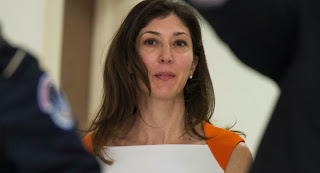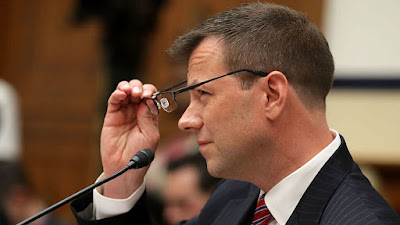Question for Durham: Was It All to Impress A Woman?
Not since John Hinckley shot President Reagan to impress actress Jodi Foster has a lovesick suitor caused as much political havoc as the FBI’s Peter Strzok did in pursuit of FBI attorney Lisa Page. Or so, at least, it would appear.
The House Judiciary Committee this month will have a chance to probe this and other lines of inquiry with former special counsel John Durham as it regards his investigation of the apocryphal Trump-Russia connection. Although a useful guide, the Durham report never got beyond the shallow end of the deep state. Congress needs to go deeper.
Both Page and Strzok were in a position to shape outcomes. In 2016, while their courting was still more or less covert, the 35-year-old Page served as an advisor to then-FBI Deputy Director Andrew McCabe. The 45-year-old Strzok, despite his adulterous affair, was promoted later that year to be deputy assistant director of the FBI’s counterintelligence division.
On March 3, 2016, Page texted Strzok, “God trump is a loathsome human.” In this series of texts, as in most, it is Page who initiates the Trump bashing and Strzok who plays along to curry her favor. Page, in particular, has little use for any Republican. “Would he be a worse president than cruz?” she asks. Responds Strzok, “Trump? Yes, I think so.”
Of the two, the higher-ranking Strzok had more influence, and he did not hesitate to use it. In leading the FBI investigation into Hillary Clinton’s email server, Strzok was the one who changed the description of Clinton’s mischief from “grossly negligent,” which could have led to criminal charges, to “extremely careless,” which did not.
As readily as Page expressed her disgust with that “enormous douche” Donald Trump, she gushed about Hillary. Inevitably, Strzok whispered what Page wanted to hear. “And hey. Congrats on a woman nominated for President in a major party,” he texted on July 25, the opening day of the Democratic National Convention. Still, Page could not conceal her unease: “She just has to win now. I’m not going to lie, I got a flash of nervousness yesterday about trump.”
The following day, Page texted Strzok, “Have we opened on him yet?” The “him” of course, was Trump. By “opened” Page meant opened an investigation. She linked to an article from the left-wing blog, Talking Points Memo, titled, “Trump & Putin. Yes, It’s Really a Thing.”
The article by editor Josh Marshall repackaged the D.C. gossip about Trump’s “deep financial dependence on Russian money” and “conspicuous solicitousness to Russian foreign policy interests.” Strzok responded to Page, “This article highlights the thing I mentioned to you earlier.” He promised to send it to his boss, Bill Priestap.
On that same July 26, reports Durham, Hillary Clinton “approved a campaign plan to stir up a scandal against U.S. Presidential candidate Donald Trump by tying him to Putin and the Russians’ hacking of the Democratic National Committee.” Within days, a CIA analyst received intelligence about this plot and promptly forwarded it to CIA Director John Brennan.
That last week of July was action packed. On July 28, FBI headquarters received for the first time “information from Australia regarding comments reportedly made in a tavern on May 6, 2016 by George Papadopoulos, an unpaid foreign policy advisor to the Trump campaign.”
Just three days after receipt of that information, July 31, a Sunday, Strzok “authored and approved” a full investigation. He did this, according to Durham, “without ever having spoken to the persons who provided the information.” Strzok and crew impishly called the investigation “Crossfire Hurricane” after a lyric in the Rolling Stones song, “Jumpin’ Jack Flash.”
Strzok did not text Page about this breakthrough until late on the night of July 30. They had apparently talked by phone before then. “Damn this feels momentous,” he wrote. “Because this matters. The other one [the Hillary Clinton investigation] did, too, but that was to ensure we didn’t F something up. This matters because this MATTERS.”
On August 2, in London, two days after opening Crossfire Hurricane, Strzok and a supervisory agent finally met with the Australian diplomat whose meeting with Papadopoulos triggered Crossfire Hurricane. According to the FBI’s legal attaché in London, the Australians had a hard time believing the FBI would open a full investigation into Papadopoulos on nothing more than this single encounter. Strzok apparently had his misgivings as well, reportedly telling the attaché, “There’s nothing to this, but we have to run it to ground.”
Strzok arrived back in Washington late on Wednesday, August 3. He missed the most critical meeting of all. This was one in which CIA Director John Brennan claimed to have briefed President Obama and other key players about what Durham calls the “Clinton Plan intelligence”—meaning the plot by the Hillary Clinton camp to link Trump to Putin.
Durham cites as evidence Brennan’s contemporary notes. He gives the notes and their author too much credence. When interviewed, Brennan admitted to not “focusing” on the Clinton Plan at the meeting. He may not have even mentioned it.
On Friday, August 5, Strzok attended a follow-up meeting. He texted Page afterwards that the meeting “[w]ent well, best we could have expected.” There was one complication, he noted, and here he quoted an unnamed official—”the White House is running this.” The “this” was not an investigation into the Clinton Plan. The “this” was the sabotage of the Trump campaign and presidency.
Neither the White House nor the FBI had any interest in exposing Clinton. Reports Durham, “The FBI never opened any type of inquiry, issued any taskings, employed any analytical personnel, or produced any analytical products in connection with the information.” The White House did not have to give Strzok orders to ignore the Clinton Plan. He had motives of his own. “[Trump’s] not going to become president, right? Right?!” Page texted anxiously on August 8. “No. No, he’s not,” her Lochinvar responded. “We’ll stop it.”
For the next month, the pair exchanged little useful information. Strzok explained why: “So just make a rule, no texts of a discoverable nature.” Page did, however, continue to share her contempt for Trump, and Strzok expanded the scope of contempt to include Trump’s supporters. “Just went to a southern Virginia Walmart,” he texted on August 26. “I could SMELL the Trump support.”
On September 7 Strzok was sent a reminder about the Clinton Plan, specifically a referral memo from the CIA “discussing US presidential candidate Hillary Clinton’s approval of a plan concerning US presidential candidate Donald Trump and Russian hackers hampering US elections as a means of distracting the public from her use of a private email server.” Neither Strzok, nor any other FBI agent, followed up.
The FBI brass had more interest in that international man of mystery Christopher Steele. The FBI agent who met with Steele in London on July 5 made note of the fact that Steele was working with “HC,” Hillary Clinton. Strzok had doubts of his own about Steele. On September 23, he messaged a fellow agent about a Michael Isikoff article that had leaked the dossier’s content. “Looking at [Isikoff’s] Yahoo article,” Strzok wrote, “I can definitely say at a minimum [Steele’s] reports should be viewed as intended to influence as well as to inform.”
On October 11, Strzok expressed his skepticism once again. He sent a message to Office of General Counsel attorney Kevin Clinesmith noting that Steele’s “unnamed client” was “presumed to be connected to the [Clinton] campaign in some way.”
If George Papadopoulos was the Rosencrantz of this investigation, Carter Page was the Guildenstern. These two “foreign policy advisers” found themselves caught in a web of intrigue well above their pay grade. By October 17, the FBI was preparing a Foreign Intelligence Surveillance Act (FISA) application asking for the right to spy on the hapless Page. Strzok knew about Page’s clearly exculpatory statements, but he disregarded them as he did his own doubts about the Steele dossier. “We need to ram this through,” he emailed an obliging Clinesmith on October 18.
The next night, October 19, Strzok took a break from railroading Carter Page to watch the final debate between Hillary Clinton and Donald Trump. He provided a running update to Lisa Page who was too nervous to watch. “Oh hot damn,” he texted her at one key moment. “HRC is throwing down saying Trump in bed with Russia.” In its own way, likely intended, Crossfire Hurricane was producing results.
Two days after the debate, October 21, the Foreign Intelligence Surveillance Court approved the surveillance of Carter Page. With that application approved, the Obama Administration officially put Trump “in bed with Russia.” For the next three years, “Trump & Putin” was indeed “really a thing,” at least for the media.
At every step of the way—from soft-pedaling the Hillary server scandal, to opening Crossfire Hurricane, to meeting the Australians in London, to receiving the Clinton Plan, to ramming through the FISA application—Strzok suppressed his doubts and advanced the conspiracy against Trump. Although he had other motives for doing so, impressing his lover seems to have been high among them.
In his eagerness to please, however, Strzok got sloppy. He left his fingerprints all over the crime scene and compounded his error by refusing to speak with Durham. By cooperating, Brennan was able to cover his tracks and protect his boss. Obama. of course, kept his hands conspicuously clean. On Inauguration Day 2017, national security adviser Susan Rice famously memorialized his fastidiousness, reminding future historians that Obama and his people did everything “by the book.”
As to Strzok, well, every good conspiracy needs a patsy.






Post a Comment